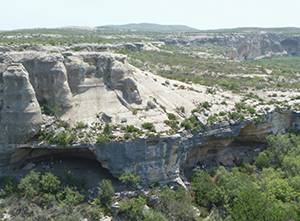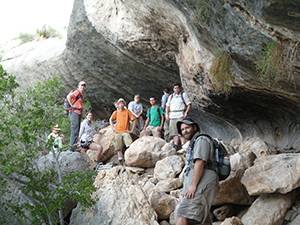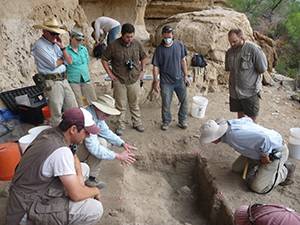Archaeological Field School at Eagle Nest Canyon
2013 Texas State University Lower Pecos Canyonlands Archaeological Field School at Eagle Nest Canyon
 The 2013 Eagle Nest Canyon Field School (ENC FS) was inspiring from start (June 3) to finish (July 3) as 25 of us learned about and carried out archaeological investigations on the Canyon edge, on its sheltered walls, and in its sheltered floors. Half and half, dirt and rock art archaeology was the theme, Eagle Nest Canyon at Langtry the setting, Jack and Wilmuth Skiles our hosts, and Drs. Carolyn Boyd and Steve Black our leaders. The Texas State University field school’s partner, the SHUMLA School of Comstock, provided our base camp, logistical support, and half our staff, the other half being graduate students and a recent graduate supported by the E. Thomas Miller Research Fund of the Ancient Southwest Texas Project at TxState.
The 2013 Eagle Nest Canyon Field School (ENC FS) was inspiring from start (June 3) to finish (July 3) as 25 of us learned about and carried out archaeological investigations on the Canyon edge, on its sheltered walls, and in its sheltered floors. Half and half, dirt and rock art archaeology was the theme, Eagle Nest Canyon at Langtry the setting, Jack and Wilmuth Skiles our hosts, and Drs. Carolyn Boyd and Steve Black our leaders. The Texas State University field school’s partner, the SHUMLA School of Comstock, provided our base camp, logistical support, and half our staff, the other half being graduate students and a recent graduate supported by the E. Thomas Miller Research Fund of the Ancient Southwest Texas Project at TxState.
Through word, image and deed, visiting researchers helped us frame the intellectual challenges and understand critical gaps in the investigative puzzle: how did this mile-long box canyon off the Rio Grande form through geologic and human time? And what does the abundant and well-preserved evidence housed within the shelters and in the uplands overlooking the Canyons tell us about those who frequented it over more than 13,000 years? How might we apply state-of-the-art research methodologies to evaluate and go beyond what has been learned since the spring 1932 when archaeologists dug the first hole in Kelley Cave?
 The fourteen FS students spent a week on each of three research “shifts” – investigating and documenting the hot rock features of the Canyon Edge with Matt Basham, the vividly painted images of the Sheltered Canyon walls with Amanda Castaneda, Charles Koenig, and Jeremy Freeman, and the complex layers of the Canyon Shelter floors with Dan Rodriguez, plus total data station TDS mapping with Vicky Muñoz and lab processing with Mary Noell. The students learned to use both cutting-edge and traditional tools : trowel, total station, compass, GPS, pencil, handheld digital microscope, nested sieve, digital tablet, shovel, portable XRF, camera and inquisitive can-do attitude to explore the little-known fragmented archaeological record left by those for whom we lack true name: the hundreds of generations of aboriginal foragers in the Lower Pecos Canyonlands. The students used these tools to physically and digitally excavate and record the layered clues left on the walls and in the earth.
The fourteen FS students spent a week on each of three research “shifts” – investigating and documenting the hot rock features of the Canyon Edge with Matt Basham, the vividly painted images of the Sheltered Canyon walls with Amanda Castaneda, Charles Koenig, and Jeremy Freeman, and the complex layers of the Canyon Shelter floors with Dan Rodriguez, plus total data station TDS mapping with Vicky Muñoz and lab processing with Mary Noell. The students learned to use both cutting-edge and traditional tools : trowel, total station, compass, GPS, pencil, handheld digital microscope, nested sieve, digital tablet, shovel, portable XRF, camera and inquisitive can-do attitude to explore the little-known fragmented archaeological record left by those for whom we lack true name: the hundreds of generations of aboriginal foragers in the Lower Pecos Canyonlands. The students used these tools to physically and digitally excavate and record the layered clues left on the walls and in the earth.
Around the Edge we sampled five places where fire-cracked rocks were amassed and found telling patterns of discarded rocks, intact heating elements, and charred plant bits. These traces bear witness to the millennia-long tradition of baking desert plants in earth-sheltered ovens. On the flats and ridges overlooking the Canyon we also found the stone tips of Archaic dart points, a trade-market metal arrowhead, an 1868 nickel, and an agave knife, among other artifacts and features.
On the Sheltered Walls we captured precise three-dimensional digital records of the surviving traces of Pecos River style pictographs using an unprecedented documentary sequence: Structure-from-Motion photogrammetry, total station georeferencing, detailed pictographic element-by-element photography and field computer (tablet) attribute recording, handheld digital microscopy and photography, layered computer illustration and a final round of ground truthing. This approach is the vanguard of rock art documentation across the globe.
 In our excavation units into the floor of Skiles Shelter we encountered a disturbed upper deposit atop a massive flood deposit of fine sandy loam of unknown age capping a thick carbon-stained Late Archaic midden riddled with charred plant baking debris. And the bottom of the shelter has yet to be seen. In adjacent Kelley Cave our units in the upper layers of the deposits uncovered a series of overlapping ash lenses associated with charcoal, animal bones, and plant fibers that likely represent true hearths used for warm, light, and cooking. An as-yet unexplored near-surface feature between the hearth area and the mouth of the shelter has cut lechuguilla leaf bases, quids, and other plant fibers atop and below a curious layer of compact light gray silty loam, possibly applied as a mud coating. The feature may represent a pit with complex stratigraphy. The lower layers of Kelley Cave have not been reached.
In our excavation units into the floor of Skiles Shelter we encountered a disturbed upper deposit atop a massive flood deposit of fine sandy loam of unknown age capping a thick carbon-stained Late Archaic midden riddled with charred plant baking debris. And the bottom of the shelter has yet to be seen. In adjacent Kelley Cave our units in the upper layers of the deposits uncovered a series of overlapping ash lenses associated with charcoal, animal bones, and plant fibers that likely represent true hearths used for warm, light, and cooking. An as-yet unexplored near-surface feature between the hearth area and the mouth of the shelter has cut lechuguilla leaf bases, quids, and other plant fibers atop and below a curious layer of compact light gray silty loam, possibly applied as a mud coating. The feature may represent a pit with complex stratigraphy. The lower layers of Kelley Cave have not been reached.
The 2013 Eagle Nest Canyon Field School was a tremendously rewarding educational experience for all involved. The combination of dirt and rock art archaeology and the spectacular setting was unique among archaeological field schools past and present. At times it was hot, windy, and wet from sweat and rain, but we stretched our minds and muscles, honed traditional and cutting-edge skills, and we had a lot of fun. The field school ended on a sustained high note, friends and colleagues departed reluctantly.
A week after the field school ended, TxState graduate students Rodriguez and Basham, assisted by student volunteers, returned to continue rockshelter excavations and documentation and sampling of upland features overlooking Eagle Nest Canyon. Work continues apace. Learn more about the 2013 ENC FS at the Annual Meeting of the Texas Archeological Society, October 25-27 in Del Rio.
